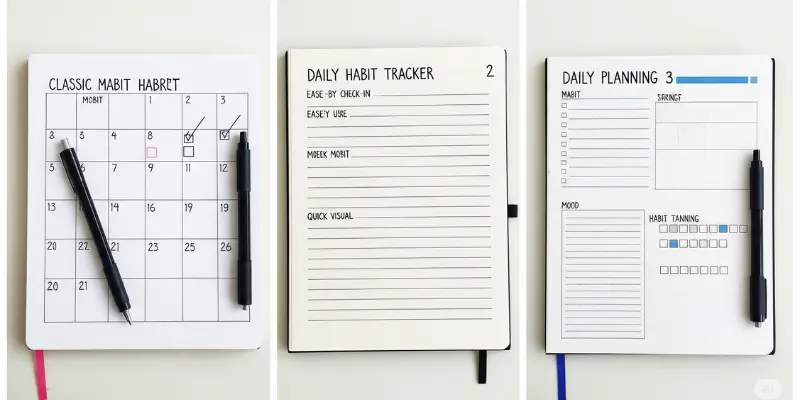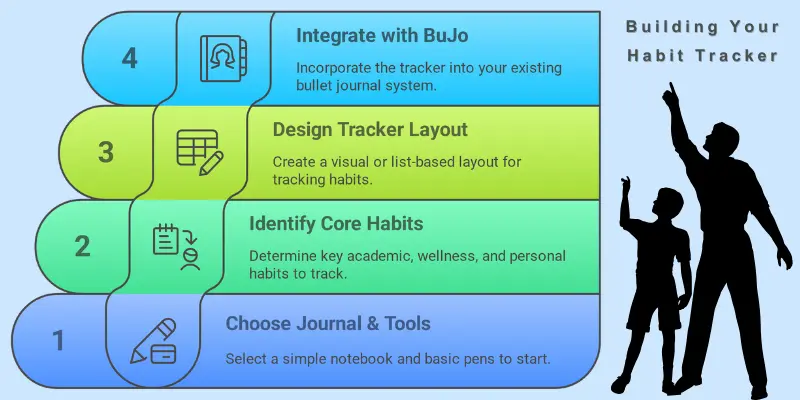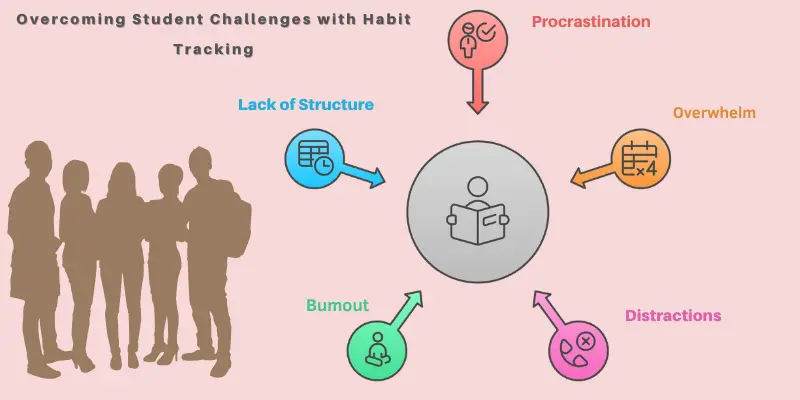Bullet Journal Habit Tracking for Students: Your Complete Step-by-Step Guide
Published: 04/07/2025
Feeling overwhelmed by studies, deadlines, and personal goals? Struggling to stick to new habits like studying consistently or getting enough sleep? As a student, it can feel like you’re constantly juggling multiple tasks, and time seems to slip away faster than you’d like.
We all know the unique challenges students face—time management, distractions, and stress can make it hard to stay focused and organized. But what if there was a way to bring some structure and consistency to your hectic life?
Enter the bullet journal. This flexible and visually engaging tool is a game-changer for students looking to track their habits and boost productivity. It’s not just about writing things down; it’s about creating a system that works for you. With habit tracking, you can stay on top of your studies, health, and personal goals—without feeling overwhelmed.
In this guide, you’ll learn how to set up, use, and maintain a bullet journal habit tracker to achieve consistency, improve your grades, and enhance your overall well-being.
Why Habit Tracking is Your Secret Weapon for Student Success
As a student, you’re balancing many things at once: classes, assignments, exams, and personal goals. It can be overwhelming, but habit tracking is the secret weapon that can help you manage it all and unlock your full potential. Here’s why:

Build Essential Routines
Creating consistent habits is the foundation of success. With habit tracking, you can build routines that support your academic and personal goals. Whether it’s consistent study times, healthy eating, or incorporating exercise into your schedule, tracking helps you stay on track and build these habits into your daily life.
- Set specific study times each day
- Track your water intake for hydration
- Build a regular exercise routine to stay healthy
Boost Productivity & Time Management
Seeing your progress visually is incredibly motivating. When you track your habits, you get a clear picture of how much you’re accomplishing. This boosts productivity and helps with time management, as you can see where you’re spending your time and make adjustments for maximum efficiency. Tracking keeps you accountable, and the more progress you see, the more motivated you’ll feel.
- Stay on top of deadlines
- Use your time more effectively
Reduce Procrastination & Overwhelm
One of the biggest challenges students face is procrastination. Habit tracking helps reduce that overwhelming feeling by breaking tasks down into manageable, bite-sized pieces. With visual accountability, tasks seem less daunting, and you can focus on one step at a time.
- Track small tasks like reading a chapter or completing an assignment section
- Reduce procrastination by visualizing the progress you’re making
Improve Focus & Academic Performance
Good habits translate directly into better performance. By tracking study sessions, rest breaks, and review times, you’ll notice improved focus and better results. Habits like consistent study and planning for revision sessions help you stay sharp and improve your academic performance over time.
- Consistent studying equals better understanding and retention of material
- Review and track your grades to monitor improvement
Enhance Mental Health & Well-being
It’s not just about academics; habit tracking also helps you prioritize self-care. Students often neglect their mental health in favor of academic success. Tracking habits like sleep, mindfulness, hydration, and breaks supports overall well-being, reducing stress and burnout.
- Track your sleep to ensure you’re rested
- Practice mindfulness and record daily reflections for mental clarity
- Take breaks throughout the day to refresh
What Makes a Bullet Journal Perfect for Student Habits?
A bullet journal is a flexible, customizable, and analog system that combines the power of a planner, diary, and to-do list all in one. It’s incredibly simple yet effective, allowing you to track your habits, tasks, and goals in a way that suits your unique needs as a student. Unlike rigid planners, a bullet journal can be tailored to fit your lifestyle, giving you full control over how you organize and track your habits.
Why Not Just an App?
While digital apps are convenient, there’s something powerful about using an analog system like the bullet journal. For students, reducing screen time is a huge benefit—it helps you disconnect and focus on what really matters. Writing things down by hand also promotes active engagement, which can lead to better memory retention. When you physically write your habits down, you’re more likely to remember them and stay consistent, compared to passively ticking off boxes on an app. The act of journaling is not just about tracking; it’s about engaging with your progress in a more mindful and intentional way.
Essential BuJo Components for Habit Tracking
A bullet journal is made up of a few core components that work together to make habit tracking efficient for students.

- Key (symbols): These symbols are used to signify tasks, events, or notes, helping you quickly navigate your journal.
- Index: The index acts as a table of contents for your journal, helping you easily locate habit tracking pages and other important sections.
- Future Log: This is where you can plan long-term goals or track upcoming habits over months.
- Monthly Log: This is where habit tracking shines—offering a snapshot of the month so you can quickly see your progress and adjust.
- Daily Log: This is your go-to for daily habit tracking, allowing you to quickly log actions and check in on your goals. It’s ideal for students needing quick, daily updates.
Your Step-by-Step Guide: Building Your First Habit Tracker Spread
Creating a habit tracker in your bullet journal is one of the most rewarding ways to stay organized, focused, and on track with your goals as a student. Let’s walk through the easy steps to set up your very first habit tracker.

Choose Your Journal & Tools
First things first—don’t worry about expensive supplies! All you need to get started is a simple notebook and basic pens. You don’t need fancy bullet journals or high-end materials. Any notebook with blank or dotted pages will work perfectly, and a few different colored pens or a black pen is all you need to get creative.
Identify Your Core Student Habits
Now, let’s talk about the habits you’ll want to track. As a student, it’s important to focus on habits that support your academic success, wellness, and personal growth. But remember—start small! Choose 1-3 key habits to track, so you don’t feel overwhelmed right from the start.
Academic Habits:
- Consistent study hours
- Working on assignments or projects
- Reading required texts or revision
- No-phone during study sessions
Wellness Habits:
- Getting enough sleep (7-8 hours)
- Daily exercise (even a 10-minute walk)
- Hydration (track water intake)
- Mindfulness or meditation (5-10 minutes daily)
- Meal prepping (prepare for healthy eating)
Personal Habits:
- Reading for pleasure (a chapter or two daily)
- Spending time outdoors (a walk or quick break outside)
- Connecting with family/friends (calling a loved one)
- Learning a new skill (e.g., learning to cook, photography, etc.)
By tracking just a few habits, you’re setting yourself up for long-term consistency and avoiding the feeling of being overwhelmed.
Design Your Tracker Layout
Now it’s time to choose the layout that will work best for your needs. Here are a few popular options for students:
- Monthly Grid:
This classic layout gives you a visual overview of the month and lets you track each habit daily with a simple checkbox or symbol. It’s great for students who like to see their progress at a glance.
Why it works: It’s simple, effective, and allows for easy tracking of multiple habits over the month. - Line-by-Line List:
If you prefer something more straightforward, a line-by-line list could be perfect. Write down each habit you want to track down the side of the page, and then simply check off or mark it daily.
Why it works: It’s quick, no-fuss, and perfect for beginners who want something easy to set up. - Tracker with Daily Reflection:
This tracker includes space for a quick “how did I do?” or a reflection on how you felt that day. You can add a smiley face, a star, or a simple note to capture your mood and progress.
Why it works: It helps you stay accountable, while also letting you reflect on how your habits are impacting your day-to-day life. - Yearly Tracker for Long-Term Goals:
For larger goals like a dissertation progress or a reading challenge, a yearly tracker is a great way to keep tabs on your long-term commitments. This is perfect for monitoring progress over several months or a whole academic year.
Why it works: It’s perfect for tracking goals that don’t fit into monthly or daily layouts.
Integrating with Your Existing BuJo Flow
Once you’ve designed your habit tracker, it’s important to make it a natural part of your bullet journal flow. You can either integrate it into your monthly logs to track your habits for the entire month or place it into your daily logs if you prefer a more detailed daily check-in. This ensures your habit tracker becomes a seamless part of your journal, not an additional task.
For example, if you’re already tracking your daily to-do lists or goals, simply add your habit tracker to the bottom of your daily spread. This way, you’ll have everything in one place and won’t forget to log your habits!
By following these steps, you’ll create a personalized habit tracker that suits your needs and supports your goals. Whether it’s for academic success, wellness, or personal growth, your bullet journal can help you stay organized and focused.
Habits That Stick: Pro Tips for Student Consistency
Staying consistent with your habit tracker can be challenging, but with the right strategies, you can make your tracking routine stick. Here are some pro tips to help you maintain consistency and see lasting results with your bullet journal.

Start Small & Build Momentum
The key to consistency is starting small. The principle from the book Atomic Habits teaches us to make habits so tiny that they’re nearly impossible to skip. Instead of saying, “I’ll study for two hours,” start with just 10 minutes. This tiny habit is easy to build into your routine and will help you gain momentum. Once you’ve mastered small habits, you can gradually build up over time.
- Example: “Study for 10 minutes” instead of “study for 2 hours”
- Focus on small wins to build confidence.
Place it Where You See It
Visual cues are incredibly powerful. For students, keeping your habit tracker visible makes it impossible to forget. Whether it’s on your desk, next to your bed, or on your study wall, the more you see it, the more likely you are to track your habits daily.
- Tip: Keep your bullet journal within arm’s reach so you’re constantly reminded to update it.
- Place it somewhere you’re sure to see it every day, like your desk or near your bed.
Don’t Break the Chain (But Forgive Yourself!)
Building streaks of completed habits is motivating, but life happens! If you miss a day, don’t stress—it’s about progress, not perfection. Just get back on track the next day. The Don’t Break the Chain method is effective, but don’t let a missed day derail your entire progress.
- Tip: Miss a day? No big deal. Just get back at it the next day without guilt.
- Reminder: Missing a day is data, not failure.
Reward Your Progress
Rewards are a great way to stay motivated. Celebrate small wins to keep your momentum going. Choose rewards that align with your interests and are accessible, like 30 minutes of video game time, a favorite snack, or a quick social media break.
- Example Rewards:
- 30 minutes of video games
- A favorite snack or drink
- A short break to listen to your favorite podcast
Link Habits to Routines
Habit stacking is a simple but effective way to make new habits stick. Link your new habits to existing routines to make them more natural. For example, “After I drink my morning coffee, I’ll track my sleep” or “Before checking social media, I’ll log my water intake.”
- Examples of Habit Stacking:
- After my morning coffee, I track my sleep.
- After my last class, I update my assignment tracker.
- Before opening social media, I log my water intake.
The “Why” Behind Each Habit
To stay motivated, connect each habit to your larger goals. Whether it’s improving academic performance, reducing stress, or feeling healthier, knowing the why behind your habit tracking gives you a deeper sense of purpose.
- Example: Track sleep to improve focus and productivity.
- Connect habits to bigger goals like better grades or improved well-being.
Review and Adjust Regularly
Regularly reviewing your progress is crucial. Set aside time weekly or monthly to check in on your habits and tracker. What’s working well? What needs adjustment? By reviewing and adjusting your habits, you ensure that your tracker remains relevant and effective.
- Tip: Set a reminder to review your habit tracker weekly or monthly.
- Adjust your habits as needed to stay aligned with your goals.
By applying these simple tips, you can build a habit tracker that not only sticks but helps you achieve lasting student success. Consistency is the key to making your habits work for you, and with these strategies, you’ll be on your way to becoming more productive, organized, and focused in no time!
Overcoming Student Obstacles with Your Habit Tracker
As a student, you face various challenges that can hinder your success and well-being. Habit tracking in your bullet journal can be an incredibly effective tool for overcoming these common obstacles. Let’s dive into how your habit tracker can help you tackle these hurdles head-on.

Challenge 1: Procrastination & Lack of Motivation
Procrastination is a major issue for many students, often fueled by lack of motivation or feeling overwhelmed by tasks. A visual streak in your habit tracker can be a powerful motivator. When you see your progress on paper, it builds momentum, making it harder to break the chain. Additionally, breaking tasks into small, manageable steps allows you to tackle them one by one, reducing the intimidation factor.
- Solution: Track small study sessions or specific assignments. Each day you complete a task, mark it off and build your visual streak. This simple act creates motivation through visible progress.
Challenge 2: Overwhelm & Too Many Commitments
With multiple commitments—studies, social life, work, and personal goals—students often feel overwhelmed. Using your habit tracker to prioritize tasks and visualize your workload helps you break down large tasks into smaller, manageable chunks. This gives you a clearer view of your day and helps you stay organized.
- Solution: List your tasks in your bullet journal, then allocate specific times to complete them. You can easily track what’s urgent and what can wait, reducing the feeling of being pulled in too many directions at once.
Challenge 3: Distractions (Phones, Social Media)
Distractions from phones and social media are among the biggest productivity killers for students. Tracking “no phone” hours or setting boundaries in your habit tracker makes you more mindful of your digital habits. This simple action increases awareness, helping you take control of your screen time and reduce distractions.
- Solution: Use your habit tracker to log no phone hours or social media-free zones. Setting and tracking these boundaries can help you stay focused during study sessions and decrease the urge to check your phone constantly.
Challenge 4: Burnout & Stress
Constant studying without taking breaks leads to burnout and stress, which negatively affects both mental and physical health. Your bullet journal can encourage a healthier balance by tracking self-care habits like sleep, hydration, and taking breaks. Recognizing when you need to rest and scheduling it into your habit tracker will help you recharge and avoid exhaustion.
- Solution: Add habits for rest days, mental health breaks, and mindfulness. By tracking these self-care practices, you ensure that you’re giving yourself the time needed to stay healthy and productive.
Challenge 5: Lack of Structure in Remote Learning
For students learning remotely, the lack of a structured schedule can be a huge challenge. A bullet journal provides the routine and structure that remote learning can lack. By setting up daily and weekly habits in your tracker, you can establish a concrete routine, helping you stay focused and organized despite the fluidity of your schedule.
- Solution: Create daily and weekly spreads that help you track your study sessions, breaks, and other key tasks. This ensures that no matter where or how you’re learning, you have a clear and consistent structure to follow.
By using your bullet journal habit tracker, you can actively combat these common student challenges and create a more balanced, productive, and well-organized student life. Start tracking today and feel the difference it can make in overcoming procrastination, overwhelm, distractions, burnout, and more.
Taking Your Student Habits Further: Advanced Bullet Journal Techniques
Once you’ve mastered the basics of habit tracking, it’s time to take your productivity to the next level. Advanced bullet journaling techniques can help you integrate all aspects of your student life, from assignments to personal well-being. Let’s explore how you can optimize your bullet journal for maximum academic success.
Integration with Grade Trackers or Assignment Logs
A powerful way to make your bullet journal a comprehensive productivity tool is by integrating grade trackers or assignment logs. By linking your habit tracking with your academic performance, you can see the direct impact of your consistent effort. This holistic approach helps you visualize how habits like studying regularly and staying organized translate into better grades.
- Tip: Create a section for tracking upcoming assignments, due dates, and grades. Combine this with your study habits to see the correlation between consistency and success.
Custom Collections for Specific Student Needs
One of the best features of a bullet journal is its customization. Custom collections are pages dedicated to specific tasks, goals, or projects. Whether it’s an Exam Study Tracker, a Reading List Progress page, or a Project Milestones log for larger assignments, custom collections allow you to keep everything organized in one place. These personalized pages help you manage long-term academic goals and make sure nothing falls through the cracks.
- Example: Track progress for your dissertation, or keep a Career Prep section to organize internship deadlines and job applications.
Using Color-Coding for Different Habit Types
For a more visually organized and instantly scannable habit tracker, try color-coding your habits. Assign a specific color to each category, such as academic habits, wellness habits, and personal habits. This adds a visual layer of organization, making it easier to track progress and identify patterns at a glance.
- Tip: Use one color for study-related habits, another for wellness routines like exercise, and a third for personal goals. This quick visual distinction helps you stay on top of all areas of your life.
By using these advanced bullet journaling techniques, you can elevate your student productivity and take control of your academic and personal goals with ease. Whether you’re tracking grades, planning for exams, or simply managing your well-being, your bullet journal becomes a powerful tool for staying organized and focused.
Conclusion: Your Journey to Consistent Habits Starts Now!
Bullet journaling is a powerful tool for student habit tracking. By organizing your habits in a way that’s tailored to your unique needs, you can transform your daily routines and stay focused on achieving your academic and personal goals. Whether you’re looking to improve productivity, stay on top of assignments, or prioritize self-care, the bullet journal offers a flexible and customizable system to help you succeed.
Remember, consistency is key, but it’s about progress, not perfection. Start small, celebrate each step, and trust that these small habits will compound over time to bring you closer to your goals. Your journey to better habits and lasting change begins now.
Ready to transform your student habits? Grab your bullet journal and start tracking today!
Share your favorite student habit to track in the comments below!
Your Top Questions Answered: Bullet Journal Habit Tracking for Students
Not at all! While some bullet journals look artistic, the core method is incredibly simple and flexible. Our guide focuses on minimalist, functional setups perfect for students who need quick, effective habit tracking without the fuss.
You can set up a basic habit tracker in under 5 minutes! Once you know the simple layouts, it’s quick. The real time-saver is how much clarity and focus it brings to your daily routine.
Absolutely not! Consistency is the goal, but perfection isn’t. Missing a day is part of the process. Simply mark it, acknowledge it, and focus on starting fresh the next day. The bullet journal helps you get back on track, not shame you.
Yes, definitely! By breaking down large tasks into smaller, trackable habits (e.g., “study for 30 mins,” “write 1 paragraph”), your bullet journal makes the work seem less daunting. Seeing your progress also builds momentum, which crushes procrastination.
Start with 1-3 core habits that will have the biggest impact: consistent study time, adequate sleep, and hydration are great places to begin. Once those stick, you can gradually add more.
Nope! All you need is a simple notebook and any pen you enjoy writing with. While fancy supplies exist, they’re completely optional. Focus on function over aesthetics, especially when starting out.
Daily check-ins for marking off habits are key. A quick weekly review (5-10 minutes) helps you see patterns and adjust. A monthly review (15-20 minutes) is great for setting new goals and refining your system for the next month.
A bullet journal complements digital tools perfectly! It acts as your personal, screen-free hub for planning and reflection, freeing you from digital distractions. You can track habits here and use apps for reminders or larger project management.
Trying to track too many habits at once! This leads to overwhelm and giving up. Our biggest advice: pick just one or two habits to master first, then slowly add more as you build confidence.
Absolutely. Tracking habits you want to reduce (e.g., social media scrolling, late-night gaming) can make you more aware of your patterns and help you consciously make better choices. It’s about awareness, not judgment.
The visual progress of a habit tracker is a powerful motivator. Seeing a chain of completed days for “study time” or “assignment work” provides a sense of accomplishment and reinforces positive behavior, making you want to keep the streak going.
It’s for all your goals! Students often juggle academics, social life, health, and personal development. Your bullet journal habit tracker is flexible enough to support all areas, helping you build a balanced and fulfilling student life.

- Be Respectful
- Stay Relevant
- Stay Positive
- True Feedback
- Encourage Discussion
- Avoid Spamming
- No Fake News
- Don't Copy-Paste
- No Personal Attacks

- Be Respectful
- Stay Relevant
- Stay Positive
- True Feedback
- Encourage Discussion
- Avoid Spamming
- No Fake News
- Don't Copy-Paste
- No Personal Attacks




